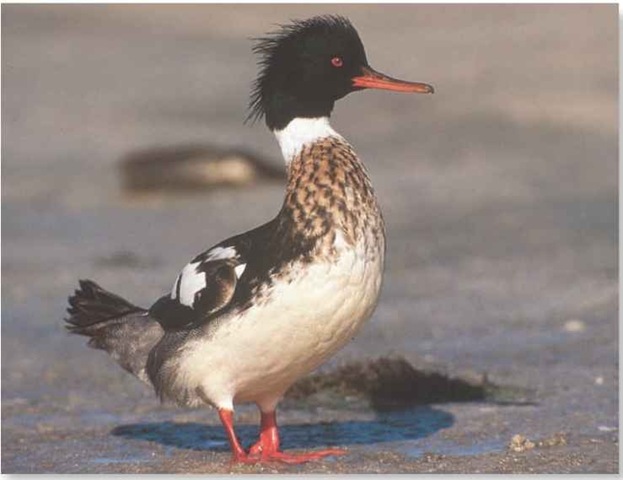ORDER
Anseriformes
FAMILY
Anatidae
GENUS & SPECIES
KEY FEATURES
• Scans the water’s surface for prey
• Females commonly gather their hatchlings to form one brood, which becomes the responsibility of the group
• During courtship, the male stretches his neck and sprints across the water before mating
WHERE IN THE WORLD?
Found in northern
Europe, Asia and North America; winters on the Atlantic and Pacific coasts, the Gulf of Mexico and the Great Lakes
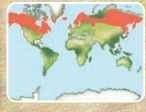
Lifecycle
Flocks of red-breasted mergansers descend upon the sea, in search of small fish and their eggs; nicknamed the fish duck, the merganser will eat almost nonstop.
HABITAT
During the breeding season, red-breasted mergansers can be found along the coast around inland lakes and streams in northern Europe, Canada, Greenland and Alaska. The duck’s range extends into the tundra areas; as a ground nester, it does not need to have trees in its habitat.The merganser prefers areas with different types of cover, such as boulders, cavities and grassy habitats.
This migratory bird has the widest distribution of all mergansers in both the Old and NewWorlds.The greatest southern migrations occur in October and November, when huge flocks form and head south to the marshes, lakes, ponds and streams on the Atlantic and Pacific coasts. The migration north from the coasts to the breeding grounds begins in March and ends in May. Red-breasted mergansers spend the summer in their breeding range across the North American, European and Asian continents.
Friendly neighbors Red-breasted mergansers often share their coastal home with other birds, such as gulls.
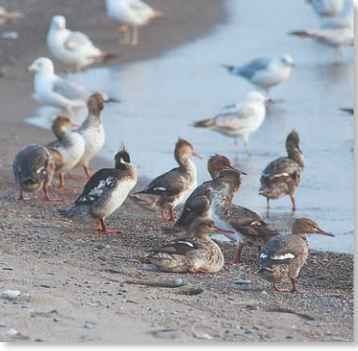
SEEK AND DEVOUR
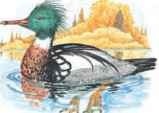
Reconnaissance mission…
An accomplished swimmer, the merganser uses its powerful feet to propel itself through the water in search of fish prey.
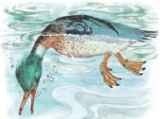
A view from below…
The merganser dips its head under the surface, swinging its crested head from side to side as it eagerly scans for fish.
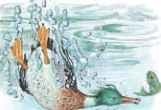
Stick with the chase…
In one quick motion, the merganser plunges itself into the water in pursuit of its prey; the trout cannot escape this persistent hunter.
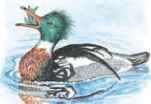
Gone with the fish
The duck’s serrated bill holds the fish in place as it swims to the surface, holding the prize in its mouth and swallowing it whole.
BREEDING
A number of males (drakes) surround a female during courtship, vying for her interest — she will choose the most impressive suitor The males perform extensive neck-stretching, followed by bobbing, vocalizations, drinking, preening and wing-flapping. The male also appears to skip over the water as he makes his approach to the female. Unlike other mergansers, the red-breasted species builds its nest on the ground, usually on small islands in freshwater lakes or nearthe sea, under some kind of cover— old logs, roots, even beach trash. If there is a shortage of nesting sites, more than one female may lay her eggs in the same nest.The female lays 7-12 olive to gray eggs; the chicks hatch, covered in gray down, in 26-28 days.The young are soon strong enough to run outside the nest and climb onto their mother’s back. It is not uncommon for several females to raise and care for their chicks in one brood. After about 60 days, the red-breasted merganser chicks are on their own.
Opposing plumage The difference between the sexes is obvious.
FOOD & HUNTING
A notorious glutton, the red-breasted merganser eats incredible amounts of food. Fish are this diving duck’s favorite meal, including trout, salmon, sand smelt, blenny, roach, gudgeon pike, rock bass, spotted shark, hake, herring and whiting. The bird also eats eels, crustaceans and water insects.
The merganser typically feeds by placing its head underwater and scanning for fish. Once it spots one, the duck immediately dives, grabs the fish and brings it to the surface, where it swallows its victim whole. The merganser will often take a drink of seawater after it has gulped down its prey. Flocks will frequently feed together, often launching their attack in unison, which usually creates quite a stir on the surface.
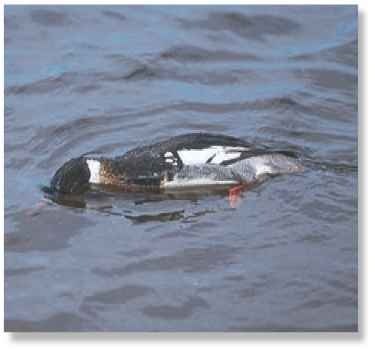
A Underwater scan Before diving, the merganser surveys for food.
CONSERVATION
The red-breasted merganser is not endangered. Since its meat is fairly inedible, the merganser is not sought after by hunters. But in Scotland and Ireland, where increasing numbers of the bird pose a threat to salmon and trout, there are bounties for dead mergansers.
On land, the merganser often rests flat on its belly or stands at a 45° angle.
The merganser’s appetite for fish is so huge that the bird may need to regurgitate part of its meal before it can fly.
BEHAVIOR
The red-breasted merganser is most at home in the water or in the air: The duck flies close to the water, and its wings create a slight whistling sound. On land, the duck seems awkward as it walks and often stops to rest on its belly. These agile divers are fairly quiet birds, with the male uttering a rough da-ah and the female answering with a croaking kha-kha-kha during courtship.
Nibbles and twists A meganser bends and twists its head to preen its feathers.

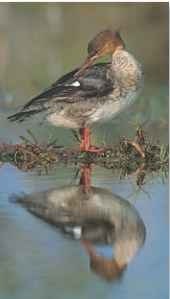
PROFILE
Red-breasted Merganser
Both the male and female red-breasted merganser have a characteristic fuzzy crest that flattens when the large, sleek fish eater is about to dive.
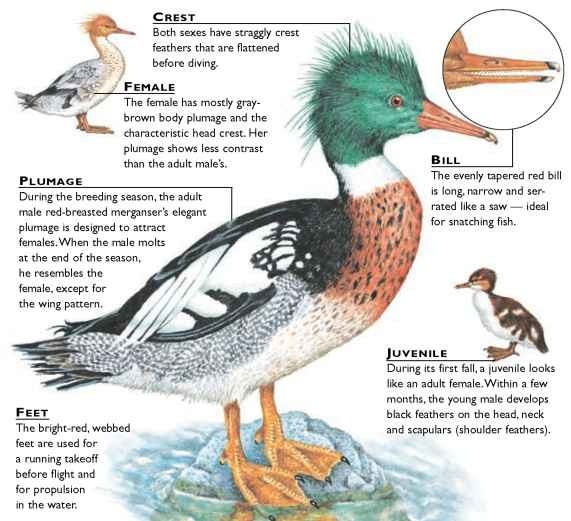
CREATURE COMPARISONS
At 7-8″ in length, the hooded merganser (Mergus cuccullatus) is much smaller than the red-breasted merganser and not as common. It is easily distinguishable from its close relative by its hooded plumage, which the male displays during breeding season. In both species, male and female mergansers have a similar appearance outside the breeding season.Though both species have the same clutch sizes and incubation periods, the hooded merganser is a tree nester and the red-breasted merganser builds its nest on the ground. Both species winter along the Pacific and Atlantic coasts.
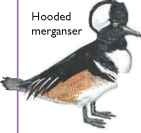
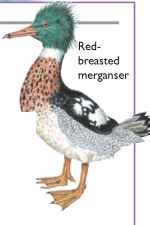
| VITAL | |
| STATISTICS | |
| Weight | 2.5 lbs. |
| Length | 19-26″ |
| Sexual Maturity | 2 years |
| Breeding Season | March-May or June-July, depending on the region |
| Number of Eggs | 7-12 |
| Incubation Period | 26-28 days |
| Fledging Period | 60 days |
| Birth Interval | 1 year |
| Typical Diet | Mainly fish; also crustaceans, water insects, earthworms |
| Lifespan | Unknown |
RELATED SPECIES
• The red-breasted merganser is 1 of 6 ’1 species in the genus Mergus, which includes the scaly-sided merganser, M. squamatus. There are a total of 41 genera and 147 species in the family Anatidae, which includes ducks, geese and swans ranging in size from the large, 6′-long trumpeter swan, Cygnus buccinator, to the small, I’-long African pygmy goose, Nettapus auratus.
